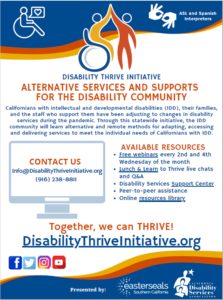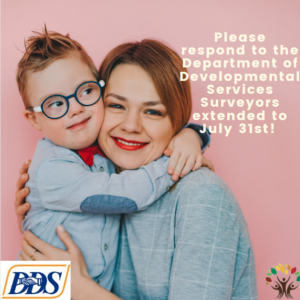Wednesday is expected to be the hottest day of the week around the Bay Area, with temperatures ranging from 15 to 25 degrees above normal. Remember to check on vulnerable people including the individuals we serve and ensure they are all safe! #HeatWave #StaySafeOutdoors #SummerSafety
Board of Director’s Public Meeting – July 10th
The Next Board Meeting is on July 10, 2024 at 6:00 pm at the NBRC’s Napa Office or via Zoom.
610 Airpark Road
Napa, CA 94558
Please click the link below to join the Zoom Webinar:
https://us02web.zoom.us/j/89709687840?pwd=QjlIcTc0dzBBNXA2OEpLanVjOFltUT09
Or Telephone: 1 669 900 6833
Webinar ID: 897 0968 7840
Password: 912329
Please contact (707) 256-1224 for information or accommodations. Spanish & American Sign Language translation services are provided.
Se Habla Español
American Sign Language Interpretation Available
Office Closure Wednesday June 19th
Please respond to DDS Surveyors-Deadline Extended from June 30th to July 31st
The Department of Developmental Services (DDS) has surveyors calling clients and/or their family members and are inquiring about their satisfaction of regional center services. This is a safe survey that will help us increase the quality of our services provided and will let us know where we can improve. We thank you in advance for your participation!
Office Closure Monday May 27th
Office Closure Monday April 1st
In observance of Cesar Chavez Day, our offices will be closed on Monday April 1, 2024. Our after-hours service remains available for non-medical emergencies at 1-800-884-1594. Known as a Latino American civil rights activist, Cesar Chavez led in the struggle for fair wages and humane working conditions for farm workers and their families. In honor of his cause, we wish you a Happy Cesar Chavez Day!
Board Meeting in Napa – April 3rd at 6pm
The Next Board Meeting is on April 3, 2024 at 6:00 pm at NBRC’s Napa Office or via Zoom.
610 Airpark Road, Napa, CA 94558
Please click the link below to join the Zoom Webinar:
https://us02web.zoom.us/j/89709687840?pwd=QjlIcTc0dzBBNXA2OEpLanVjOFltUT09
Or Telephone: 1 669 900 6833
Webinar ID: 897 0968 7840
Password: 912329
Please contact (707) 256-1224 for information or accommodations. Spanish & American Sign Language translation services are provided.
Se Habla Español
American Sign Language Interpretation Available











